Options: Miscellaneous
The Miscellaneous pane offers several options to control many things about memoQ:
- Translation: Options about confirming segments, importing and exporting documents, and showing progress
- Lookup results: Controls how memoQ displays suggestions for segments, and what those suggestions are. You can set up MatchPatch here, for example.
- Languages: Controls which languages memoQ shows at the top of lists.
- Weighted counts: When memoQ runs Statistics, it can compute the weighted word count, so that you have an idea how much you need to work on fuzzy matches. You can set the weights for each match category.
- Default TM scheme: Defines the extra fields that new translation memories get on this machine.
- Editing time: Use this to make memoQ measure the time it takes to translate or edit segments - again, on this machine.
- Proxy settings: Use this if you cannot properly activate memoQ over the network.
- Discussions: Choose if you want to receive notifications about the discussions on the memoQ servers you are connected to.
How to get here
- Open the Options window: At the very top of the memoQ window - in the Quick Access toolbar
 -, click the Options (cogwheels)
-, click the Options (cogwheels)  icon. The Options window opens.
icon. The Options window opens. - Under Category, click Miscellaneous. The Miscellaneous pane appears.

What can you do?
- Warn when confirming segments with identical source and target check box: If this is check box is checked, memoQ displays a warning message each time you attempt to confirm a segment where the target text is identical to the source text. This prevents you from overlooking segments where the source text was accidentally copied to the target cell. Normally, memoQ does not do this.
- No warning if only formatting or tags differ check box: If this is checked, memoQ does not display a warning message if the source and the target text is identical but the formatting tags or the inline tags are different. Normally, memoQ does this if it checks for identical source and target segments.
- Only warn if segment contains at least one content word check box: If this is checked (normally it is), memoQ does not display a warning message if the source text contains numbers and/or punctuation marks only. It is quite natural to copy such segments to the target cell. Normally, memoQ does this if it checks for identical source and target segments.
- Enable preview for translations check box: If this check box is checked (normally, it is), memoQ creates a preview for every supported document when it imports the document. In the translation editor, memoQ shows the preview pane. If the check box is not checked, memoQ does not create a preview, and hides the preview pane. This setting does not affect documents that are already imported, or documents that come from a different copy of memoQ.
- Automatically synchronize offline TMs and TBs with documents in online projects check box: If this check box is checked, and the user synchronizes documents from the local copy of an online project, memoQ also synchronizes the offline translation memories and term bases that are being used in the project. Normally, memoQ does not do this: only documents are synchronized when the user synchronizes an online project.
- Show translation progress (%) based on radio buttons: Choose what memoQ should count when it calculates the progress of a document or an entire project. You have three choices:
- Segments: memoQ compares the number of confirmed or proofread segments to the total number of segments in the document or the project.
- Words: memoQ compares the number of source words in confirmed or proofread segments to the total number of source words in the document or the project.
- Characters: memoQ compares the number of source characters in confirmed or proofread segments to the total number of source characters in the document or the project.
The default setting is Words.
- Allow replacement in source segments: Normally, Find and replace does not work in source segments. You can turn it on here: check this check box.
- Enable pop-up notifications: If this check box is checked, memoQ displays popup windows with further information at the bottom of the window. Click the letter icon to open up the messages. Normally, memoQ does this.
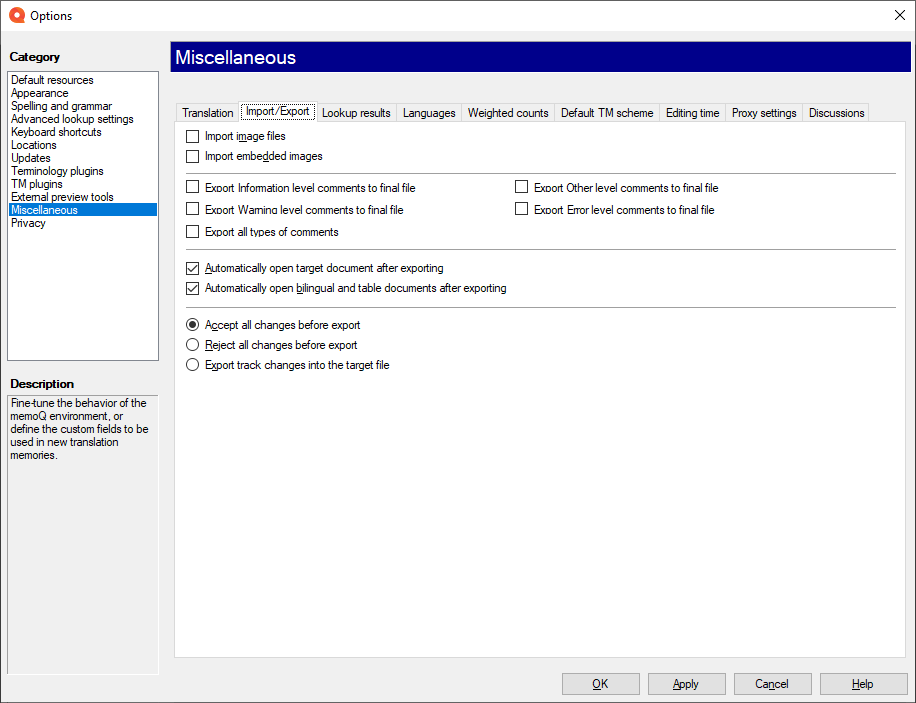
- Import image files check box: If this check box is checked, memoQ imports image files for translation. Normally, memoQ does not do this.
- Import embedded images check box: If this check box is checked, memoQ imports images that are embedded in documents. Normally, memoQ does not do this.
You can specify what comments get exported in DOCX files. Normally, memoQ does not export any. You can choose to export the following types (check the check boxes):
- Export Information level comments to final file: Exports information-type comments to the final DOCX file.
- Export Warning level comments to final file: Exports warning-type comments to the final DOCX file.
- Export Error level comments to final file: Exports error-type comments to the final DOCX file.
- Export Other level comments to final file: Exports other comments to the final DOCX file.
- Export all types of comments: Exports all comments to the final DOCX file.
You can choose what happens after a document is exported:
- Automatically open target document after exporting: If this check box is checked, memoQ opens the documents automatically after export when you choose to Export (stored path) or Export (choose path). Normally, memoQ does this.
- Automatically open bilingual and two-column documents after exporting: If this check box is checked, memoQ opens the documents automatically after export when you export a bilingual format (except for XLIFF). Normally, memoQ does this.
Note: memoQ does not open the documents when you export more than 5 documents at once.
Finally, you can decide how tracked changes are exported - if there are any in the translation:
- Normally, memoQ exports the "final" version - the document will be saved with all changes exported. This is the Accept all changes before export radio button.
- To export the version before the changes: Click Reject all changes before export.
- To export the markup - the tracked changes - with the document: Click Export track changes into the target file.
This works for Word documents.
memoQ will use these options if you import documents with the Use the global options setting. To learn more, see Help about the Document import settings window.

- Append space to inserted terms: If this check box is checked, memoQ writes a space at the end of any term you insert into the target cell from the Translation results list. Normally, memoQ does not do this.
- Inserting a TM or corpus match overwrites target segment: If this check box is checked, and the user inserts a translation memory or a corpus match, memoQ replaces the entire contents of the current target cell. If the check box is not checked, memoQ inserts the match into the text at the cursor position. Normally, memoQ does this.
- Show highlights: If this check box is checked, memoQ highlights terms and auto-translatable elements in the source text that are listed in the Translation results pane. Normally, memoQ does this.
- Patch fuzzy TM matches: If this check box is checked, memoQ will attempt to fix matches automatically. Check the Include TM fragments (LSC hits) to include partial matches in the automatic fixing. Check the Store patched match rate instead of the original match rate check box if memoQ should overwrite the TM match with the fixed match, and display the fixed match rate at the bottom right corner in the Translation results pane. A fixed match can never have a match rate higher than 94%.
- Filter and limit translation memory and corpus hits: If this check box is checked, memoQ omits identical translation memory and corpus matches from the Translation results list, and also limits the number of matches in the list. Normally, memoQ does this.
- Maximum number of translation memory and corpus hits shown: memoQ will not display more translation memory and corpus hits on the Translation results list than the number in this box. The default value is 5.
- Show corpus hits without a translation: If this check box is checked, memoQ will list hits from LiveDocs corpora that contain no translation (for example, they come from a monolingual document in the corpus). Normally, memoQ does this.
- Longest source term hides shorter matches check box: If the term bases in the project contain more than one term for the same part of the source text, and one term is longer than another, memoQ will display only the longer one on the Translation results list. Normally, memoQ does this.
- Using the two radio buttons under Display order of term base hits, you can control how memoQ sorts the terms in the Translation results list:
- Order of appearance in text: memoQ lists the terms as they appear in the source text. This is the default.
- Alphabetical: memoQ lists the terms in alphabetical order of the source terms.
- Order term base hits primarily by rank and metadata check box: memoQ ranks the term base hits according to the rank of each term base in the project, and also from the metadata for the project (client, domain, subject). If you do not check this check box, then the source position is first, and then the TB ranking, and the same with the alphabetical order: the alphabetical order precedes the ranking.
- Show term base hits with empty target check box: If this is checked, memoQ displays term base entries where there is no target-language equivalent in the current target language. This indicates that the highlighted phrase is a term in other languages, and the translator may need to find an appropriate target-language equivalent. Normally, memoQ does this.
Useful for term extraction: A term extraction session can return hits like a term base, but there are many entries where the target-language equivalent was not yet filled in. This is also similar to concordancing monolingual documents in LiveDocs corpora.
- Check for duplicates when adding new terms: If this check box is checked, memoQ checks the term base for duplicate entries when you add a new term to a term base.
- Delay before showing translation results box: Normally, memoQ waits half a second (500 milliseconds) before showing any lookup results. You can customize this value in entering a value between 0 and 1000 milliseconds in the box. You can speed up the display of the lookup results, or delay them even more.
- Compare boxes: Use these radio buttons to switch between Track changes view and Traditional view in the compare section of Translation results.
- Compare different views: Click this link to see how the two views look like.
On this tab, you can choose preferred languages that appear at the top of the language lists.
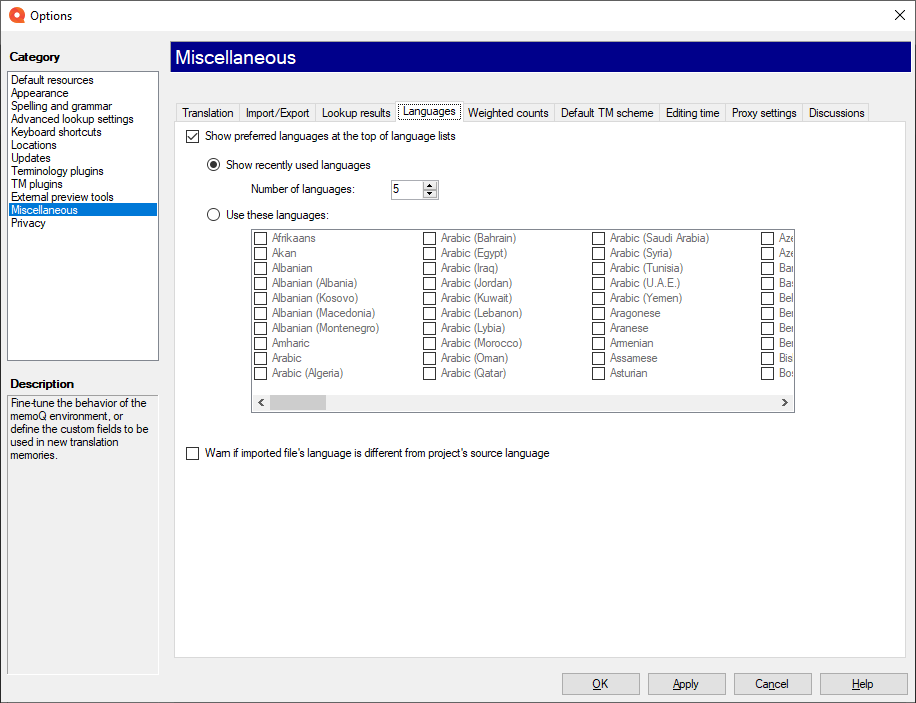
Normally, memoQ shows the 5 last used languages at the top of each language list.
- To show more: Change the number in the Number of languages box.
- To show a fixed set of languages: Click the Use these languages radio button. Check the check box for each language you want to see at the top of the lists.
- To turn off preferred languages: Clear the Show preferred languages at the top of language lists check box.
memoQ prevents the import of a document in the wrong language: Normally, memoQ warns you if, for example, you import a French document into an English-German project. To stop this, clear the Warn if imported file's language is different from project's source language check box.
In this tab, you can set the weight for each match category, so that memoQ can compute weighted word counts when it runs Statistics. But what are they?
Compared to translating the text from scratch, you need to work less on a segment if there's a translation memory match - in theory. Before you start working, you need to have an idea how much that work will be. Especially when the job is about upgrading the translation of some documents to newer versions. In this case, the actual translation work can be as little as 10% (or less) of the total word count of the source documents - because for much of the text, you can use the translation from before.
memoQ gives you the word counts grouped by match categories: you'll know how many words are in segments that have 100% matches; how many have 95-99% matches etc.
For each match category, you can have a weight. The weight is between 0% (no work at all) and 100% (translating every word from scratch). You multiply the word count in a category by the weight. Then you'll have a theoretical, weighted, word count.
Example: If a segment has a 90% match, that usually means a difference of one word. Your weight for that match category (85-94%) could be 50%. If the segment is 10 words, you count 5 words for that segment.
Counting this makes sense only if your project has at least one translation memory or LiveDocs corpus.
To set the weights, use the Weighted counts tab:
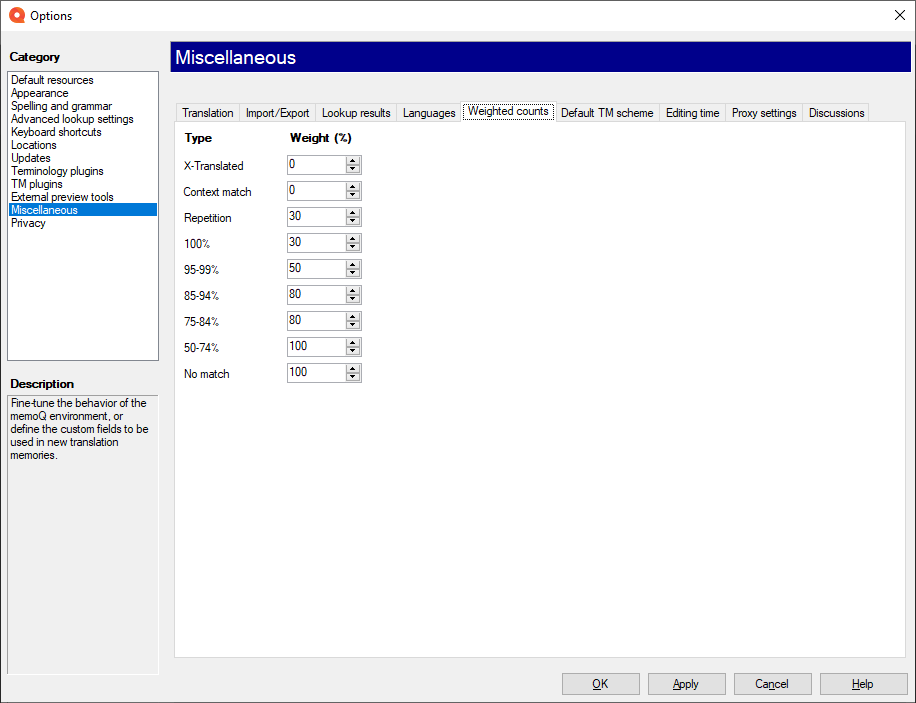
The image above shows the weights that are set up in memoQ at the beginning. To change them, simply change the numbers in each box.
Valid for new projects only: You cannot change the weight settings of existing projects here.
This tab lists the custom fields that are used in every new translation memory that is created on your computer. The changes you make here will not affect existing translation memories.
Maximum 20 custom fields: A TM scheme cannot contain more than 20 custom fields.
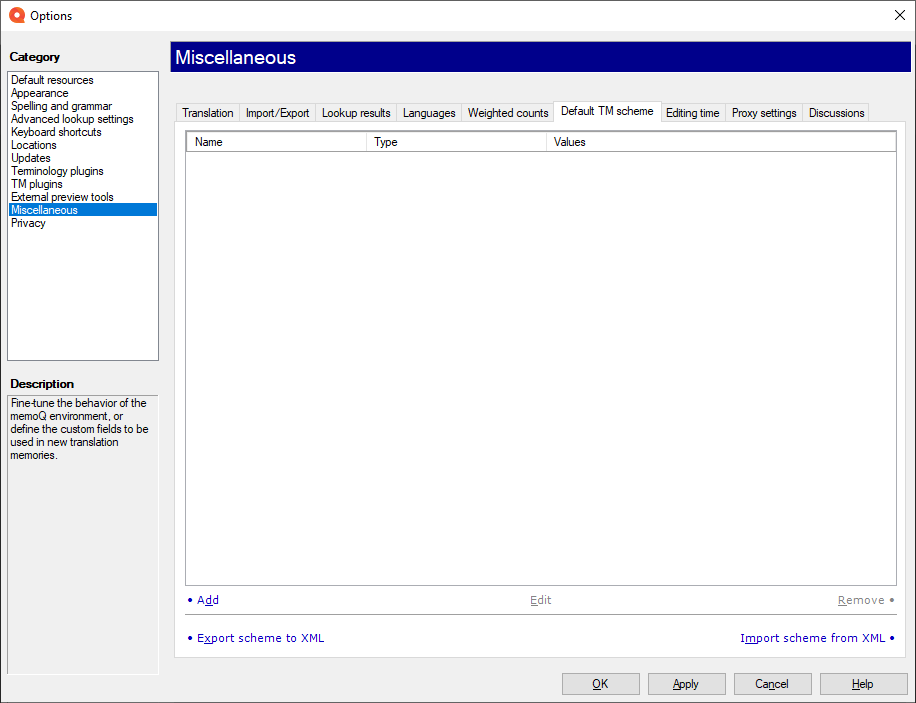
The following options are available:
- Add: Adds a new custom field to the default TM scheme. The Custom field properties window opens. Specify the name and the type of the new custom field. If you choose Picklist (single) or Picklist (multiple) for the type, you need to list the possible values for the field.
- Edit: Changes the type of the selected custom field. You cannot change the name. The Custom field properties window opens. The Name box is grayed out. You can change the type. If you choose Picklist (single) and Picklist (multiple), you can also change the list of possible values.
- Remove: Removes the selected custom field from the list.
- Export scheme to XML: Exports the details of custom fields in an XML file. You can copy this file to another computer, so that the new translation memories will have the same custom fields there, too.
- Import scheme from XML: Imports details of custom fields that were saved to an XML file earlier, possibly from another copy of memoQ.
Use this tab to measure your editing time.
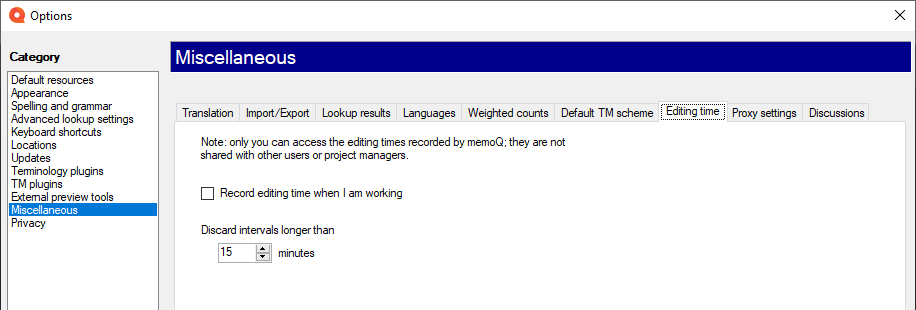
Normally, memoQ records the time you spend working on each segment. To stop this, clear the Record editing time when I am working check box.
The translation editor shows this time for each segment: Next to the clock icon, you see the time you spent working on the current segment.

You can create a report from the time spent editing. This report can only be created in local projects, or checkouts of online projects.
If your network uses a proxy server, you need to configure proxy settings in memoQ, so that it can update licenses over the internet. To configure proxy settings, use the Proxy settings tab the to set up the proxy settings.
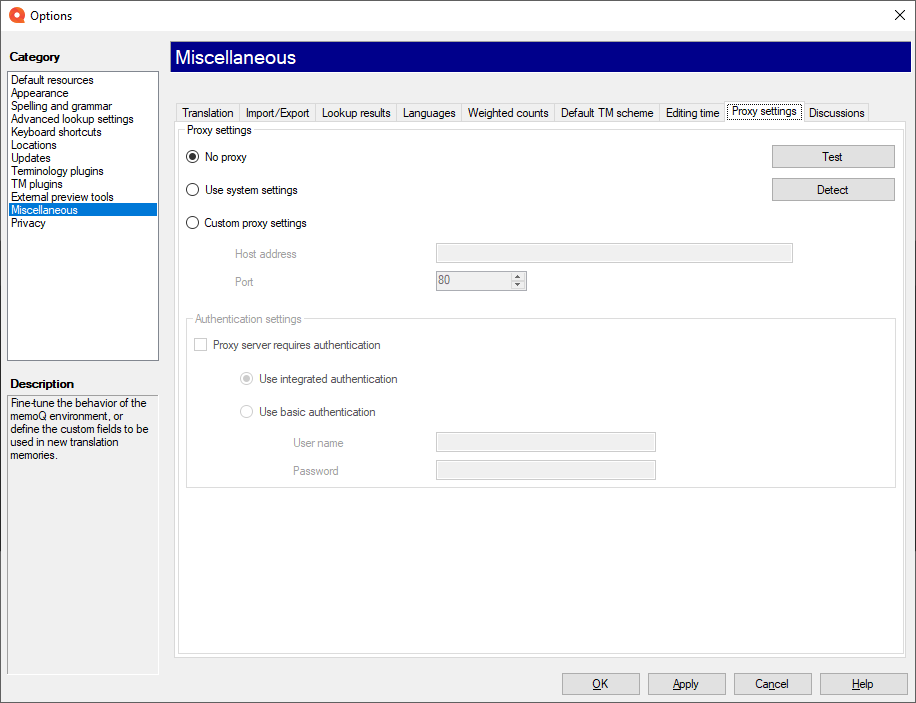
In this tab, you can configure the proxy settings for memoQ.
- Proxy settings section:
- No proxy: Most networks do not use a proxy server. Normally, memoQ will attempt to contact memoQ Ltd.'s activation server directly over the internet. This will fail if your network uses a proxy server to access the internet.
- Use system settings:Choose this option to use the settings of your network's proxy server for memoQ. Click the Detect button to detect the proxy settings for your setup.
- Custom proxy settings: Choose this option to enter custom proxy settings. Enter the host address in the text field. Choose a port from the drop-down list.
You may need your systems operator: You might need to obtain these details from your IT specialist.
Click the Test button to test your proxy settings.
- Authentication settings section:
- Proxy server requires authentication: Check this check box if you need to give a user name and a password to the proxy server. Use the radio buttons to choose the type of authentication:
- Use integrated authentication: Choose this option to use the integrated authentication from the system. memoQ will use your existing user name and password to access the proxy server.
- Use basic authentication: Choose this option to enter a user name and password to use a basic authentication for the proxy server. This is less secure than integrated authentication.
Click Apply to save your settings.
If you are connected to a memoQ server or two, and if there are discussions on these servers where you are involved, memoQ server can notify you in e-mail.
But if there are too many discussions, or they are too busy, the notifications can be distracting.
Normally, memoQ will send notifications about changes in every discussion.
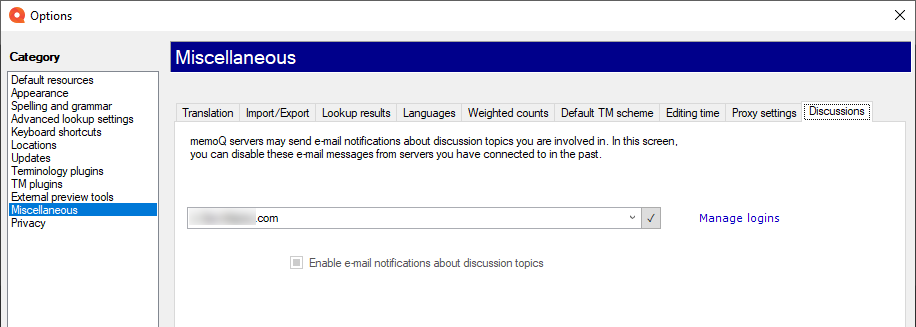
To stop receiving e-mails from a server:
- In the Server URL drop-down box, choose the server that is sending the notifications.
- Click Select. You may need to log in to that server.
- Clear the Enable e-mail notifications about discussion topics check box. This will prevent that server from sending notifications again.
- Repeat this for other servers if there are any.
Turns off discussion notifications only: You will still receive project-related e-mails from the server. This option turns off the discussion-related e-mails only.
When you finish
To save the settings and return to memoQ: Click OK.
To save the settings and remain in the Options window: Click Apply.
To return to memoQ without making changes: Click Cancel.
- Default resources: Choose default resources (segmentation rules, QA settings, ignore lists etc.) for new projects. Do not mix these with resources in project templates. If you create a project from a template, memoQ will use the settings from the template, and not from these options.
- Appearance: Font and color settings for the translation editor and the Translation results pane. Use this to make the translation editor more readable.
- Spelling and grammar: Open this to set up the spell checker. Choose to use Word or Hunspell. If you choose Hunspell, you can download and install new dictionaries. Set up the spell checker for every target language you work with.
- Advanced lookup settings: Choose how memoQ should offer automatic concordance results, and how it should put together suggestions from fragments (shorter translation memory units and terms). Do not change the defaults unless you are entirely certain that you will get better suggestions as a result. If you just tamper with these settings, you may lose productivity. To learn more about these types of suggestions, see Help about the Translation results pane.
- Keyboard shortcuts: Choose or edit keyboard shortcuts for frequent commands in memoQ. Do not change these before you learn to use memoQ thoroughly. After you change keyboard shortcuts, the Help pages may not help you find them.
- Locations: Check or change the locations of memoQ folders. These are the folders memoQ places local projects and checkouts, translation memories, term bases, and others. You may need to change these if you are running low on disk space on your default drive. Do not change them unless it is absolutely necessary. Do not place them on network drives. If you place these folders in synchronized locations (local copies of Dropbox, Onedrive etc.), memoQ may become slower.
- Updates and news: Choose how memoQ should check for updates, and opt out of receiving news if necessary.
- Terminology plugins: Set up external terminology resources. memoQ can connect to various external terminology providers.
- TM plugins: Set up access to external translation memory services.
- External preview tools: Manage preview tools that are not built into memoQ, but installed separately.
- Miscellaneous: Configure various settings that control the behavior of the editing interface of memoQ.
- Privacy: Learn about memoQ's privacy policy, and enable or disable anonymous usage data sharing with memoQ's designers and developers.